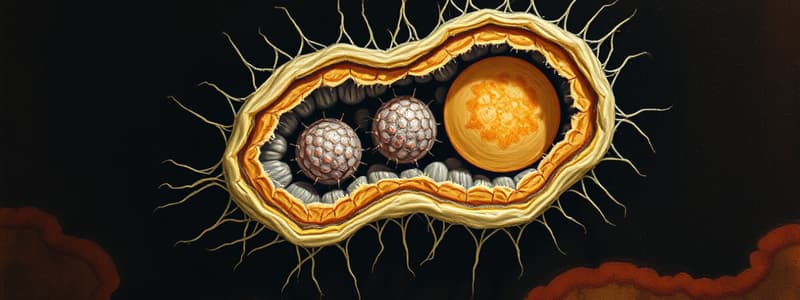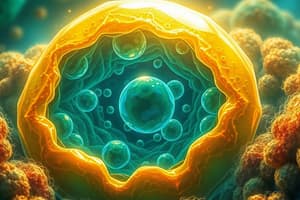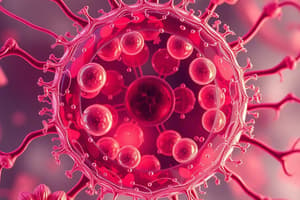Podcast
Questions and Answers
The three types of cartilage are hyaline, elastic, and ______.
The three types of cartilage are hyaline, elastic, and ______.
fibrous
Hyaline cartilage is found on the articulating surfaces of ______.
Hyaline cartilage is found on the articulating surfaces of ______.
bones
Elastic cartilage contains many ______ fibers, giving it a yellowish color.
Elastic cartilage contains many ______ fibers, giving it a yellowish color.
elastic
Fibrous cartilage contains a dense network of ______ fibers.
Fibrous cartilage contains a dense network of ______ fibers.
Bones act as ______, converting muscle contraction into movement.
Bones act as ______, converting muscle contraction into movement.
Hydroxyapatite, made from calcium and ______, gives bone its hardness.
Hydroxyapatite, made from calcium and ______, gives bone its hardness.
The development of cell theory began with ______ in 1665.
The development of cell theory began with ______ in 1665.
Organisms can be classified as unicellular or ______.
Organisms can be classified as unicellular or ______.
Cells contain hereditary information (DNA) passed from cell to cell during ______.
Cells contain hereditary information (DNA) passed from cell to cell during ______.
Cells have various types and shapes based on their ______ and positions.
Cells have various types and shapes based on their ______ and positions.
The small size of cells provides a large surface area to ______ ratio.
The small size of cells provides a large surface area to ______ ratio.
Prokaryotic cells are unicellular organisms, including ______ and archaebacteria.
Prokaryotic cells are unicellular organisms, including ______ and archaebacteria.
Non-living cell walls made of ______, located outside the plasma membrane, maintain cell shape.
Non-living cell walls made of ______, located outside the plasma membrane, maintain cell shape.
Energy flow (______ and biochemistry) occurs within cells.
Energy flow (______ and biochemistry) occurs within cells.
Spongy bones are found in the center of flat bones and the ends of ______.
Spongy bones are found in the center of flat bones and the ends of ______.
Compact bones are formed by ______ located in the lacunae.
Compact bones are formed by ______ located in the lacunae.
Haversian canals contain ______ vessels and nerves.
Haversian canals contain ______ vessels and nerves.
Osteocytes secrete a matrix of calcium phosphate, carbonate, and ______.
Osteocytes secrete a matrix of calcium phosphate, carbonate, and ______.
Nerve tissues are composed of nerve cells called ______ and neuroglial cells.
Nerve tissues are composed of nerve cells called ______ and neuroglial cells.
A typical neuron consists of a cell body, ______, and an axon.
A typical neuron consists of a cell body, ______, and an axon.
Neurons transmit impulses to other neurons, muscles, and ______.
Neurons transmit impulses to other neurons, muscles, and ______.
An axon is a single long fiber that carries impulses ______ from the cell body.
An axon is a single long fiber that carries impulses ______ from the cell body.
Striated muscle is also known as ______ muscle due to its anatomical location.
Striated muscle is also known as ______ muscle due to its anatomical location.
Cardiac muscle is found only in the ______.
Cardiac muscle is found only in the ______.
Red blood cells are formed in ______ marrow.
Red blood cells are formed in ______ marrow.
Striated muscle is essential for ______ and motion.
Striated muscle is essential for ______ and motion.
Cardiac muscle does not require ______ impulses to contract.
Cardiac muscle does not require ______ impulses to contract.
Red blood cells are filled with oxygen-carrying protein called ______.
Red blood cells are filled with oxygen-carrying protein called ______.
Blood consists of fluid and cells flowing in one direction in a closed ______ system.
Blood consists of fluid and cells flowing in one direction in a closed ______ system.
Red blood cells have a biconcave disc shape providing a large surface for ______ delivery.
Red blood cells have a biconcave disc shape providing a large surface for ______ delivery.
White Blood Cells are also known as ______.
White Blood Cells are also known as ______.
Granulocytes or agranulocytes are classified based on the presence or absence of visible ______ in the cytoplasm.
Granulocytes or agranulocytes are classified based on the presence or absence of visible ______ in the cytoplasm.
Neutrophils, eosinophils, and basophils are types of ______.
Neutrophils, eosinophils, and basophils are types of ______.
Neutrophils are highly mobile and capable of performing ______.
Neutrophils are highly mobile and capable of performing ______.
Eosinophils play significant roles in defending against ______ infections.
Eosinophils play significant roles in defending against ______ infections.
Basophils contain ______, serotonin, and heparin.
Basophils contain ______, serotonin, and heparin.
White Blood Cells can migrate to ______ to perform various functions.
White Blood Cells can migrate to ______ to perform various functions.
Granulocytes are formed in the bone ______.
Granulocytes are formed in the bone ______.
Flashcards are hidden until you start studying
Study Notes
Objectives
- Fundamental properties of cells include metabolism, structure, and genetic information.
- Distinction between prokaryotes (simple, unicellular) and eukaryotes (complex, can be unicellular or multicellular).
- Understanding cellular components in animal and plant cells.
- Overview of animal tissues and organ systems.
Cell Theory
- Organisms classified as unicellular (single-cell) or multicellular (multiple cells).
- Development of cell theory started with Robert Hooke in 1665.
- Energy flow through metabolism occurs within cells.
- Cells carry hereditary information (DNA) and are diverse in shape and size based on function.
- Small cell size enhances surface area to volume ratio, facilitating diffusion.
Prokaryotic Cells
- Unicellular organisms include bacteria and archaebacteria.
- Cell walls are non-living, made of peptidoglycan, providing structure and protection.
Cartilage Types
- Hyaline Cartilage: Most common; found in joints, respiratory passages, and sternum.
- Elastic Cartilage: Contains elastic fibers; found in the ear, ear canal, Eustachian tube, and epiglottis.
- Fibrous Cartilage: Dense collagen fiber network; found in intervertebral discs and pubic symphysis.
Bones
- Serve as levers for muscle contraction and movement.
- Hydroxyapatite (calcium and phosphate) gives bones hardness.
- Two types of bone: spongy bone (center of flat bones, ends of long bones) and compact bone.
- Compact bone structured by osteocytes in concentric circles around Haversian canals housing blood vessels and nerves.
- Osteocytes communicate via canaliculi for nutrient transport.
Nerve Tissues
- Composed of neurons (nerve cells) and neuroglial cells (support cells).
- Neurons conduct nerve impulses while neuroglial cells provide protection.
Neurons
- Typical structure includes a cell body (contains nucleus), dendrites (receive impulses), and axon (sends impulses).
- Impulses transmitted to other neurons, muscles, and glands.
Muscle Tissues
- Striated Muscle (Skeletal Muscle): Voluntary muscle connected to bones via tendons, crucial for motion.
- Cardiac Muscle: Found in heart, striated but involuntary, capable of generating its own rhythmic contractions without brain input.
Blood
- Composed of cells and plasma circulating in a closed system.
- Bone marrow is the site of blood cell formation.
Blood Cell Types
- Red Blood Cells (Erythrocytes): Biconcave discs, lack nuclei, contain hemoglobin for oxygen transport, survive about 120 days.
- White Blood Cells (Leukocytes): Protect body via immune responses, migrate from blood to tissues, categorized into granulocytes and agranulocytes.
Granulocytes
- Contain granules in cytoplasm, produced in bone marrow.
- Types include:
- Neutrophils: Highly mobile, perform phagocytosis.
- Eosinophils: Combat parasitic infections, involved in allergic responses.
- Basophils: Release histamine and other chemicals during inflammatory responses.
Studying That Suits You
Use AI to generate personalized quizzes and flashcards to suit your learning preferences.




